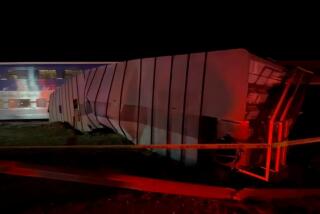Crash Brings 8 Youths’ Trip to Fateful End
- Share via
WASHINGTON — For seven months they lived, learned and worked together at a federal Job Corps center in historic Harpers Ferry, W. Va., trying to overcome their own troubled histories by mastering such workplace skills as carpentry, bricklaying, house painting and building maintenance.
Most of the 120 or so disadvantaged youths enrolled in the government-subsidized training program decided to stay in Harpers Ferry over the three-day holiday weekend. But 17 obtained passes to visit family and friends back home.
It was a fateful decision.
As authorities spent Saturday sifting through the wreckage left by the collision of two passenger trains near Silver Spring, Md., they were struck by one finding: Aside from three railroad employees, the only people killed in the Friday evening collision were Job Corps youths.
In fact, the only passengers riding in the Maryland commuter train on which all 11 fatalities occurred were students enrolled in the politically endangered training program.
With virtually no warning, the commuter train collided head-on with two 130-ton locomotives pulling a 15-car Amtrak passenger train out of Washington, bound for Chicago. Eight students perished. The others, except for one who had just disembarked at an earlier stop, escaped with injuries. All were riding in the first of three passenger cars, which were pushed from behind by a heavy locomotive.
Federal investigators said they are considering operator error as a possible cause of the accident.
Officials and onlookers said the two trains collided about 5:45 p.m. Friday. Flames erupted immediately as diesel fuel caught fire, sending acrid, dark smoke into the sky. All the victims died of burns and multiple trauma, officials said.
Police had earlier reported 12 deaths but revised that Saturday to 11, blaming the confusion on darkness, bad weather and smoke at the scene, as well as the gruesome condition of the bodies.
*
At least 26 people were injured in the crash, but none seriously among passengers on the Amtrak Capitol Limited, authorities said. The Amtrak train had left Washington only minutes before for an overnight run to Chicago.
The crash occurred in darkness, after a daylong snowfall in the area, when both trains wound up on the same stretch of track.
Deaths occurred on the commuter train because its locomotive was at the rear, pushing its three cars. Crew members operated it from a cab in the front commuter car.
The Amtrak train, which had been switched to another track to pass a slow-moving freight train, was being switched back to its original track when the accident occurred.
John Goglia, a member of the National Transportation Safety Board, told reporters Saturday night that the MARC commuter train was moving about 40 mph when it collided with the Capitol Limited, which was moving the opposite direction at 30 mph.
Just before the collision, the MARC train had been going 63 mph, Goglia said, but the operator hit the brakes about 1,100 feet before the crash, about 15 seconds before the impact.
The speed limit on that section of track is 70 mph, Goglia said.
The investigation is “moving toward the operator, since we found absolutely no difficulties anywhere else,” he said.
“There is absolutely no indication of sabotage,” he said.
If signals were working correctly, the commuter train should not have been going more than 30 mph when the operator applied the brakes, Goglia said.
Officials have not discovered any problems with the signals, but Goglia said a full test must wait until wreckage is removed from sensors in the track.
Labor Secretary Robert B. Reich, whose department runs the Job Corps program, shook his head upon visiting the crash scene Saturday.
“This would be a tragedy under any circumstances,” Reich said. “But the fact we’re dealing with young people, and young people who had the odds against them from the beginning, who had chosen to make something of their lives, who were learning skills at a Job Corps center, makes it a particularly poignant tragedy.”
*
Mary Silva, national director of Job Corps, later expressed a similar thought. “We all spend so much time talking about bad kids,” she said. “But these are kids who wanted to be good.”
Like some of the inner-city youth it serves, the Job Corps has come under harsh political attack in recent years.
Dating back to the Johnson administration, the program operates 110 centers across the country like the one in Harpers Ferry. Members of both parties have criticized the program as wasteful and poorly managed. Last year, it narrowly escaped a congressional proposal to shut 25 training centers and turn the rest over to the states.
Instead, under a compromise approved by the Senate and awaiting House consideration, the program would be subjected to a two-year review. The plan calls for eliminating 10 centers by 2000, a cut that would reduce spaces for about 4,000 youths from the present force of 39,000 Job Corps students.
Anita Race, an associate director of the Harpers Ferry center, said that the West Virginia facility was dedicated to helping qualified kids overcome some of the obstacles confronting inner-city youth.
*
“The idea is to give disadvantaged young people an opportunity to learn a trade and help them become employable in society,” she said.
The Harpers Ferry training center is next to a historic Civil War site at the convergence of the Potomac and Shenandoah rivers, about 55 miles northwest of Washington.
William Sexton, a center staffer, told Associated Press the Job Corps built most of the 13 red-brick buildings on the 77-acre campus. It also renovated a blacksmith shop at Harpers Ferry National Park and built sidewalks and an animal shelter in nearby Martinsburg.
News of the eight deaths devastated other Harpers Ferry students, Race said. “We’re all in a state of grief and shock here,” she said.
Maryland Gov. Parris Glendening, who visited the scene Saturday, called it “devastating.” “All I can pray for is that those who died, died instantaneously,” he said.
More to Read
Sign up for Essential California
The most important California stories and recommendations in your inbox every morning.
You may occasionally receive promotional content from the Los Angeles Times.













